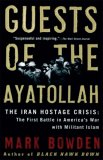Summary | Excerpt | Reviews | Beyond the Book | Readalikes | Genres & Themes | Author Bio

Critics' Opinion:
Readers' Opinion:
First Published:
Apr 2006, 704 pages
Paperback:
Mar 2007, 704 pages
 Book Reviewed by:
Book Reviewed by:
BookBrowse Review Team
Buy This Book
When the embassy opened more than four decades previously,
Tehran had been a different place, more a village than a city. The United States
was then just one among many foreign powers with diplomatic missions in Iran.
Before the chancery stood a low, decorative wooden fence that allowed an
unobstructed view of the beautiful gardens from Takht-e-Jamshid, which was then
just a quiet side street, paved with cobblestones. In those days, the new
embassy’s openness and its distance from the row of major missions on busy
Ferdowsi Avenue contributed to America’s image as a different kind of Western
power, one that had no imperial designs.
In the years since, Tehran itself had grown into a noisy,
crowded city, a bland, featureless, unplanned jumble of urgent humanity that
flowed daily in great rivers of cars through uninteresting miles of low, pale
brown and gray two- and three-story boxlike buildings. Takht-e-Jamshid’s quaint
cobblestones had long since been paved and the avenue widened. In daylight it
was clogged with cars, motorbikes, and buses. The embassy’s main entrance,
Roosevelt Gate, was named after Franklin D. Roosevelt, whose distant cousin CIA
officer Kermit Roosevelt, Theodore’s grandson, had helped engineer the 1953 coup
d’état that toppled an elected Iranian government and replaced it with the shah.
At the time, the coup had powerful Iranian backers and was welcomed by many in
the country, but today it was seen simply as a tawdry American stunt, another
example of cynical CIA meddling in the Third World.
By the fall of 1979, in the receding tide of the
revolution, the old embassy had become a provocation. It was moored like an
enemy battleship just a stone’s throw from the street, a fact demonstrated
repeatedly. For a country in a fit of Islamist, nationalist, and increasingly
anti-American fervor, such a grand and central presence in the capital city was
a daily thumb in the eye. Lately most of the harassment had been relatively
minor. The walls that now surrounded Henderson High and its campus were covered
with insults and revolutionary slogans and were topped by three feet of curved
and pointed steel bars. A few days earlier a band of young men had sneaked into
the compound and were caught shinnying up the big pole in front of the chancery
to take down the American flag. The marines had since greased the pole. As a
defense against rocks and an occasional gunshot from passing motorists, all of
the windows facing front had been layered with bulletproof plastic panels and
sandbags. The chancery looked like a fort.
While the Americans inside saw these changes as purely
defensive, the picture they presented strongly encouraged suspicion. The embassy
was an enemy foothold behind the lines of the revolution. Washington had been
the muscle behind the shah’s rule, and a big part of throwing off the monarchy
had been the desire to break Iran’s decades-long fealty to Uncle Sam. Yet here
the embassy still stood. Those Iranians who supported the United States — and
there were many still among the prosperous middle and upper classes — prayed that
its obdurate presence meant the game wasn’t over, that the free world was not
really going to abandon them to the bearded clerics. But these were an
embattled, endangered minority. To the great stirred mass of Iranians, afire
with the dream of a perfect Islamist society, the embassy was a threat. Surely
the architects of evil behind those walls were plotting day and night. What was
going on inside? What plots were being hatched by the devils coming and going
from its gates?
Why was no one stopping them?
Excerpted from Guests of the Ayatollah, (c) 2006 Mark Bowden. Reproduced by permission of Grove/Atlantic, Inc. All rights reserved.





The Flower Sisters
by Michelle Collins Anderson
From the new Fannie Flagg of the Ozarks, a richly-woven story of family, forgiveness, and reinvention.

The House on Biscayne Bay
by Chanel Cleeton
As death stalks a gothic mansion in Miami, the lives of two women intertwine as the past and present collide.

The Funeral Cryer by Wenyan Lu
Debut novelist Wenyan Lu brings us this witty yet profound story about one woman's midlife reawakening in contemporary rural China.
Your guide toexceptional books
BookBrowse seeks out and recommends the best in contemporary fiction and nonfiction—books that not only engage and entertain but also deepen our understanding of ourselves and the world around us.